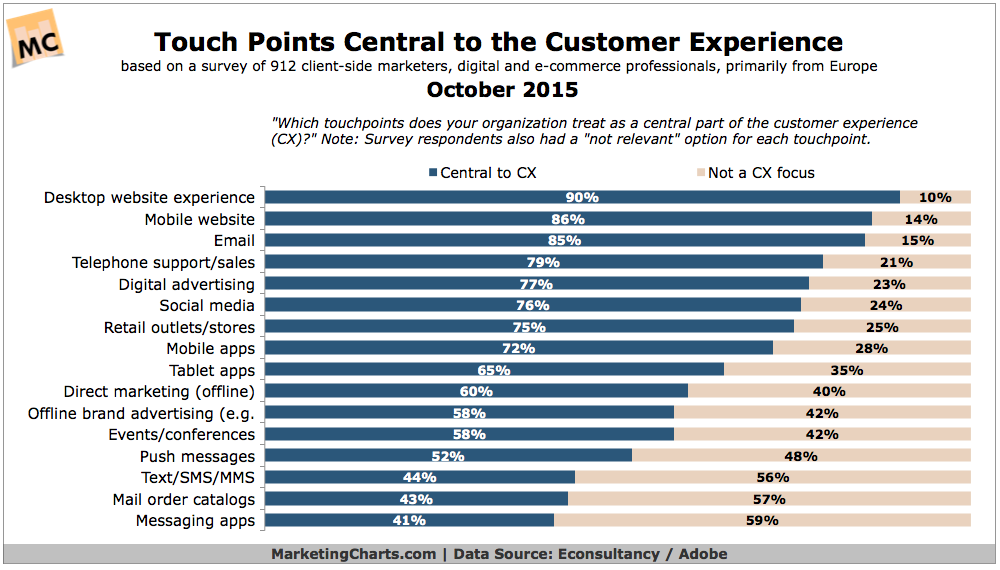The best value for the buck is no longer the deciding factor when choosing between brands. Today we hear more and more about the customer experience (CX) and how marketers are striving to implement strategies to create the best experiences possible for their customers. Research by HBR found that companies who skillfully manage and execute customer experience strategies reap enormous rewards. They achieve higher customer satisfaction, reduced churn, increased revenue, and greater employee satisfaction.
According to research by Econsultancy and Adobe, marketers ranked the following touchpoints as the most important focus for optimizing CX:
- 90% – Desktop website experience
- 86% – Mobile website
- 85% – Email
- 79% – Telephone support / sales
- 77% – Digital advertising
- 76% – Social media

The customer experience is the sum of each of these touchpoints as customers interact with a brand throughout the customer lifecycle. Each interaction should be consistent regardless of channel. In order to deliver a seamless channel experience, marketers must first have a single customer view in place.
Establish a Single Customer View
Although the concept of having a single view of customers is certainly not a new notion, many companies fail to deliver, citing lack of time, talent or resources as a barrier. According to Experian, 40% of businesses have more than 80% of their customer data stored in separate systems across the organization. However, with the advancements in technology and the availability of more sources of customer data, attaining this holistic customer view is more achievable than ever.
One of the most critical first steps in achieving a single customer view is to identify the customer data sources that should be integrated. This may be data sitting in email systems, call centers, web logs, billing history and Point of Sale systems. Additional data can also be appended such as missing contact details (address, phone number, or address) or demographics (marital status, gender, income, lifestyle, and hobbies). Be sure to then choose a technology vendor that will allow for easy integration of these data sources. Data must also be consistently maintained and cleansed to ensure customer data is always of the highest quality possible.
With a single customer view in place, customers can be treated as individuals – not just a series of disconnected touch points across different channels.
Engage and Listen to Your Customers
Delivering great customer experiences requires that you are both listening to your customers as well as engaging with them proactively. Capture customer input with surveys and polls and implement customer service surveys so customers have a forum on which they can provide feedback and be heard. Be sure to respond to any inquiries or complaints on a timely basis. Your customers want to feel valued, so show them that they are.
Beyond listening to customers, marketers must also have a proactive plan to contact customers with personalized offers and messages. This can be done in several ways:
Segmentation: Your customers don’t want to receive every offer, message, email, or direct mail piece you have. You must be selective about which offers go to which customers, depending on their individual preferences, likes, and needs. Use your data to segment customers by attributes such as purchase history, demographics, geography, lifetime value, or other notable attributes. Remember, your competitors are most likely engaging in similar strategies so be creative in how you segment, using a variety of traits to create finely tuned micro-segments in order to deliver the most targeted messaging possible.
Personalization: Whenever possible, your communications with customers should be personalized. This may be greeting your customer by first name in messages, personalizing offers based on purchase frequency, or offering a discount based on browsing history. Personalization is a huge component of the overall customer experience.
Take a look at the following stats on how personalization can add real value to your bottom line:
- 73% of consumers prefer to do business with brands that use personal information to make their shopping experiences more relevant (Digital Trends)
- 86% of consumers say personalization plays a role in their purchasing decisions (Infosys)
- 45% of online shoppers are more likely to shop on a site that offers personalized recommendations (Invesp)
- 40% of consumers buy more from retailers who personalize the shopping experience across channels (Monetate)
- 80% of consumers like when retailers emails contain recommended products based on previous purchases (Listrak)
Optimizing the Digital Customer Experience
Consumers today have more channel options than ever before. The IoT and digital media have become an integral part of our everyday lives. As the Econsultancy and Adobe research revealed, marketers are learning that digital and social experiences are more important than ever. Companies have an opportunity to set themselves apart by the digital experiences they offer.
In another study by Accenture titled “Digital Transformation in the Age of the Customer,” key findings revealed that the “customer experience is at the heart of digital transformation.” 58% of businesses now look at digital to help them sell profitability, and 56% assess the impact of digital in relation to customer experience. 80% of firms are also using third-party providers for at least one component of their digital transformation.
According to the report, “Companies are focusing on digital channels to make customer interactions more engaging: 63% are planning to enhance their online experience, 46% are looking to add or improve their mobile offerings, but only 39% want to improve their in-store experience.”
Today’s consumers are clearly in charge and each touch point can be pivotal in optimizing the customer experience and in turn, driving more growth. However, when deciding which channels to optimize first, head to the channels your customers are visiting – anything digital.
To learn how top marketers are implementing strategies to create the best experiences possible for their customers, download this Data-Driven Marketing Ebook.



